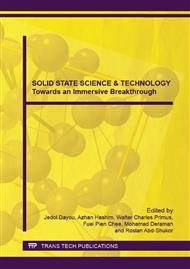[1]
S. K. Barik, R. N. P. Choudhary, A. K. Singh. Ac impedance spectroscopy and conductivity studies of Ba0. 8Sr0. 2TiO3 ceramics. Adv. Mat. Lett. 2 (2011) 419-424.
DOI: 10.5185/amlett.2011.2228
Google Scholar
[2]
D. Vladikovaa, Z. Stoynova, M. Viviani. Application of the differential impedance analysis for investigation of electroceramics. J. Eur. Ceram. Soc. 24 (2004) 1121–1127.
Google Scholar
[3]
Czekaj, A. Lisi´nska-Czekaj, T. Orkisz, J. Orkisz, G. Smalarz. Impedance spectroscopic studies of sol–gel derived barium strontium titanate thin films. J. Eur. Ceram. Soc. 30 (2010) 465–470.
DOI: 10.1016/j.jeurceramsoc.2009.06.036
Google Scholar
[4]
P. Dhaka, D. Dhakc, M. Dasa, K. Pramanik, P. Pramanik. Impedance spectroscopy study of LaMnO3 modified BaTiO3 ceramics. Mat. Sci. Eng. B 164 (2009) 165–171.
DOI: 10.1016/j.mseb.2009.09.011
Google Scholar
[5]
Pengrong Ren, Huiqing Fan, Xin Wang. Impedance spectroscopy studies of bulk electrical conduction in A-site acceptor (K)-doped BaTiO3. Journal of Materials Science, October, Volume 48: 20 (2013) 7028-7035.
DOI: 10.1007/s10853-013-7513-4
Google Scholar
[6]
N. S. Hari, P. Padmini, T. R. N. Kutty. Complex impedance analyses of n-BaTiO3 ceramics showing positive temperature coefficient of resistance. J. Mater. Sci. -Mater. El. 8 (1997) 15-22. D.
Google Scholar
[7]
T. J. Hwang & G. M. Choi. Electrical characterization of porous BaTiO3 using impedance spectroscopy in humid condition. Sensor Actuator B 40 (1997) 187-191.
DOI: 10.1016/s0925-4005(97)80260-2
Google Scholar
[8]
A. R. West, D. C. Sinclair, N. Hirose. 1997. Characterization of electrical materials, especially ferroelectric by impedance spectroscopy. J. Electroceram. 1 (1997) 65-67.
Google Scholar
[9]
Jianquan Qi, Zhilun Gui, Yongli Wang, Qing Zhu, Yajing Wu, Longtu Li The PTCR effect in BaTiO3 ceramics modified by donor dopant. Ceramics International. 28: 2 (2002) 141–143.
DOI: 10.1016/s0272-8842(01)00069-4
Google Scholar
[10]
M. M. Vijatović, J. D. Bobić, B. D. Stojanović. History and Challenges of Barium Titanate: Part II, Science of Sintering, 40 (2008) 235-244.
Google Scholar
[11]
A. K. Jonscher, The 'universal' dielectric response, Nature, 267 (1977) 5613.
Google Scholar


